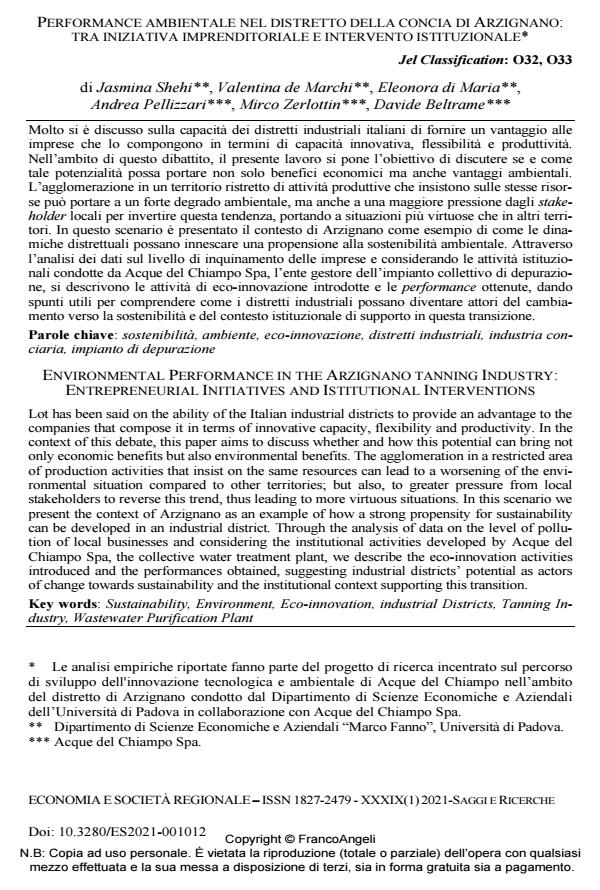Environmental performance in the arzignano tanning industry: entrepreneurial initiatives and istitutional interventions
Journal title ECONOMIA E SOCIETÀ REGIONALE
Author/s Jasmina Shehi, Valentina De Marchi, Eleonora Di Maria, Andrea Pellizzari, Mirco Zerlottin, Davide Beltrame
Publishing Year 2021 Issue 2021/1
Language Italian Pages 27 P. 152-178 File size 522 KB
DOI 10.3280/ES2021-001012
DOI is like a bar code for intellectual property: to have more infomation
click here
Below, you can see the article first page
If you want to buy this article in PDF format, you can do it, following the instructions to buy download credits

FrancoAngeli is member of Publishers International Linking Association, Inc (PILA), a not-for-profit association which run the CrossRef service enabling links to and from online scholarly content.
Lot has been said on the ability of the Italian industrial districts to provide an advantage to the companies that compose it in terms of innovative capacity, flexibility and productivity. In the context of this debate, this paper aims to discuss whether and how this potential can bring not only economic benefits but also environmental benefits. The agglomeration in a restricted area of production activities that insist on the same resources can lead to a worsening of the envi-ronmental situation compared to other territories; but also, to greater pressure from local stakeholders to reverse this trend, thus leading to more virtuous situations. In this scenario we present the context of Arzignano as an example of how a strong propensity for sustainability can be developed in an industrial district. Through the analysis of data on the level of pollu-tion of local businesses and considering the institutional activities developed by Acque del Chiampo Spa, the collective water treatment plant, we describe the eco-innovation activities introduced and the performances obtained, suggesting industrial districts’ potential as actors of change towards sustainability and the institutional context supporting this transition.
Keywords: Sustainability, Environment, Eco-innovation, industrial Districts, Tanning In-dustry, Wastewater Purification Plant
Jel codes: O32, O33
- Stratificazione, nocività e lavoro immigrato. il caso del distretto conciario della Valle del Chiampo Davide Marchi, in ECONOMIA E SOCIETÀ REGIONALE 1/2024 pp.61
DOI: 10.3280/ES2024-001005
Jasmina Shehi, Valentina De Marchi, Eleonora Di Maria, Andrea Pellizzari, Mirco Zerlottin, Davide Beltrame, Performance ambientale nel distretto della concia di Arzignano: tra iniziativa imprenditoriale e intervento istituzionale in "ECONOMIA E SOCIETÀ REGIONALE " 1/2021, pp 152-178, DOI: 10.3280/ES2021-001012